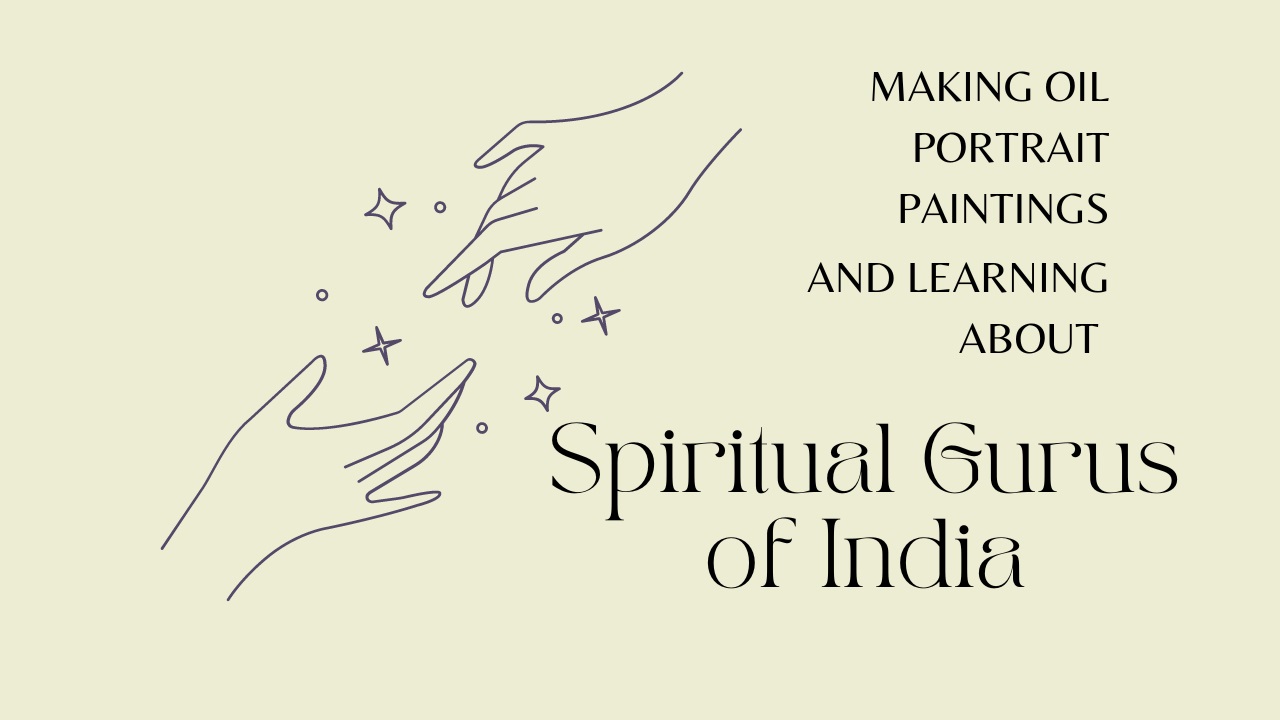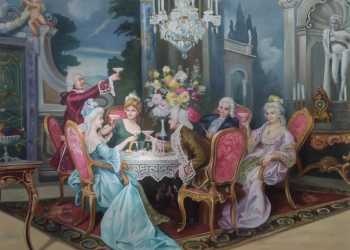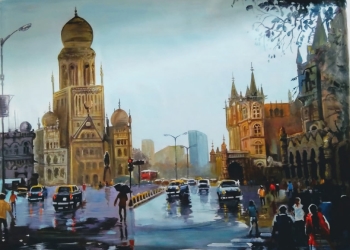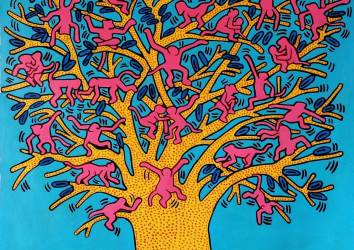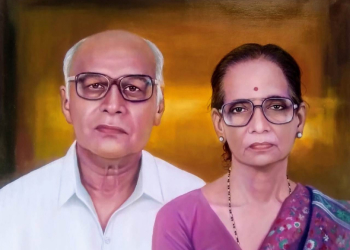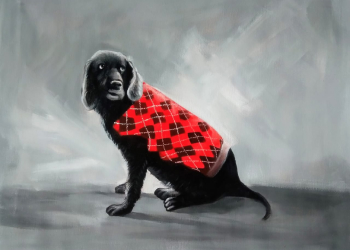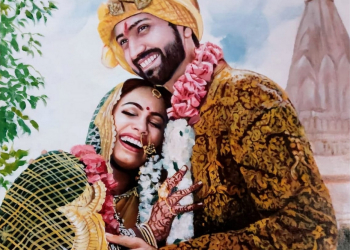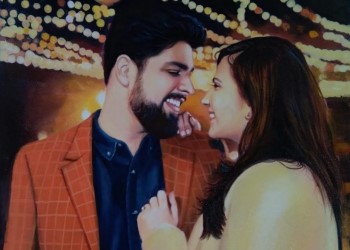In this post, we make oil portrait paintings from photos of famous Spiritual Gurus of India like Mahavatar Babaji, Sai Baba, Pramukh Swami Maharaj, Guru Jambheshwar, Nigamanda Paramhansa and Shri Rang Avadhoot Maharaj and learn about their lives.
Over the millennia, India, or Bharat Varsha, has been a land of spirituality, mysticism, meditation, contemplation, and enlightenment, with strong spiritual foundations that have thrived and continue to inspire. India is the birthplace of four of the world's seven major faiths, including Sanatan Dharma (Hinduism), Baudh Dharma (Buddhism), Jaina Dharma (Jainism), and Sikh Dharma (Sikhism). It is hardly surprising that India has produced numerous enlightened Masters and Gurus with loyal disciples.
Over time, we received many commissions from their loyal followers to paint oil portraits of their Gurus from their photos. We received commissions to create oil portrait paintings of Gurus who have left an inedible mark on this land, its great civilization, and its people. And we feel blessed and honored to have the opportunity to make their portrait paintings. Before we start making the paintings, we research the subjects to gain a better understanding of them. This enables us to capture their personalities better and depict them in a more authentic way when we make their portrait painting.
While researching them, we came across fascinating and inspiring stories about the Gurus and their life journeys and gathered a few answers to frequently asked questions by their followers.
Here we present a select few portrait paintings of the Gurus we made and their stories.
Mahavatar Babaji
Mahavatar Babaji, who has lived for hundreds of years in the Himalayas and still looks like a youth, is a story that has inspired many people to call upon him for guidance.
Mahavatar Babaji is the name given to his guru by Indian yogi Yogiraj Lahiri Mahasaya (1828-1895) and numerous of his disciples, who appeared to them between 1861 and 1935, as recounted in various books and biographies. According to Yogananda's autobiography, Mahavatar Babaji lived in the remote Himalayan regions of India for at least hundreds of years, seen by only a tiny handful of disciples and others. According to Pranabananda, Mahavatar Babaji is ageless, and no one is aware of Babaji's age, family, and place of birth.
In 1861 the accountant job with the British Government took Shymacharan Lahiri, also known as Lahiri Mahsaya to his followers and devotees, to Ranikhet where he had his first encounter with Mahavatar Babaji. He heard a voice calling his name when he was strolling in the Dunagiri highlands above Ranikhet. The tall, wonderfully bright sadhu he encountered when he followed the sound up the mountain was Mahavatar Babaji. Initiating Lahiri Mahasaya into Kriya Yoga by Mahavatar Babaji, Mahavatar Babaji revealed to him that he was his former guru and gave him the task of initiating others.
Lahir Mahasaya met Mahavatar Babaji numerous times, as mentioned in several books, including Paramahansa Yogananda's Autobiography of a Yogi.
Account of Mahavatar Babaji's childhood from a few references. According to Marshal Govindan, Nagaraj's (Mahavatar Babaji) father was the priest of the village's temple. Mahavatar Babaji became a disciple of Siddha Agastya. The secrets of Kriya Kundalini Pranayama or "Vasi Yogam" was taught to him. Mahavatar Babaji made a long pilgrimage to Badrinath and spent eighteen months practicing yogic kriya taught to him by Siddha Agastya and Bhogarnathar before attaining Siddha.
Mahavatar Babaji has been a part of popular culture for the better part of the century. Mahavatar Babaji is present in the famous pop band Beatles' 1967 album cover, Sergeant Peppers's lonely hearts band, and George Harrison's 1974 album Dark Horse. The 2002 Tamil film Baba written by Rajinikanth on Mahavatar Babaji.
Mahavatar Babaji, a devotee of Lord Shiva and many believe Mahavatar Babaji to be another incarnation of Lord Shiva himself.
We also encountered some popular questions about Mahavatar Babaji during our research.
Is Mahavatar Babaji alive?
According to legend, Mahavatar Babaji is a "deathless" Guru. It is believed Mahavatar Babaji lives in the Himalayas for hundreds of years and still retains his youth.
Where is Mahavatar Babaji?
There have been many claims of the people who live in and around Badrinath throughout the year, they have seen Mahavatar Babaji many times.
Did Rajinikanth met Mahavatar Babaji?
Rajinikanth asserts that he learned about Mahavatar Babaji through the Autobiography of a Yogi after he was introduced to him by a friend. He was first introduced to the book in 1978, but he wasn't able to read it until 1999, following the success of his movie Padaiyappa.
"While reading the book, Babaji's picture emitted a light spark," adds Rajinikanth. He was instructed to sit in a certain way by the light spark. Rajinikanth then did so, allowing the spark of light to enter him.
Mahavatar Babaji served as the inspiration for Rajinikanth's 2002 Tamil film Baba.
Making the oil portrait painting from a photo of Babaji
The above readings provided us with insights that helped us in making the portrait painting of Mahavatar Babaji, commissioned to us by one of our clients.
Commissions were received by us to make a large canvas oil portrait painting, measuring 52 inches by 54 inches of Mahavatar Babaji. We made the portrait painting of Mahavatar Babaji from a photo shared with us. The oil painting depicts Mahavatar Babaji seated on the ground in a yogic posture of padmasana (cross-legged Lotus position) deep in meditation of Lord Shiva also known as Mahadev in the Himalayas. Lord Shiva, seated on a tiger skin behind Babaji, with a serpent around his neck and adorning the crescent moon in his matted hair with his third eye closed with his kamadalu (small copper vessel) near his left hand, with a calm expression, also in deep meditation. In the distance, the snow-clad Mount Kailasha, the abode of Lord Shiva can be seen.
The painting of Mahavatar Babaji evokes the feeling of oneness with nature and the timelessness of Divinity.
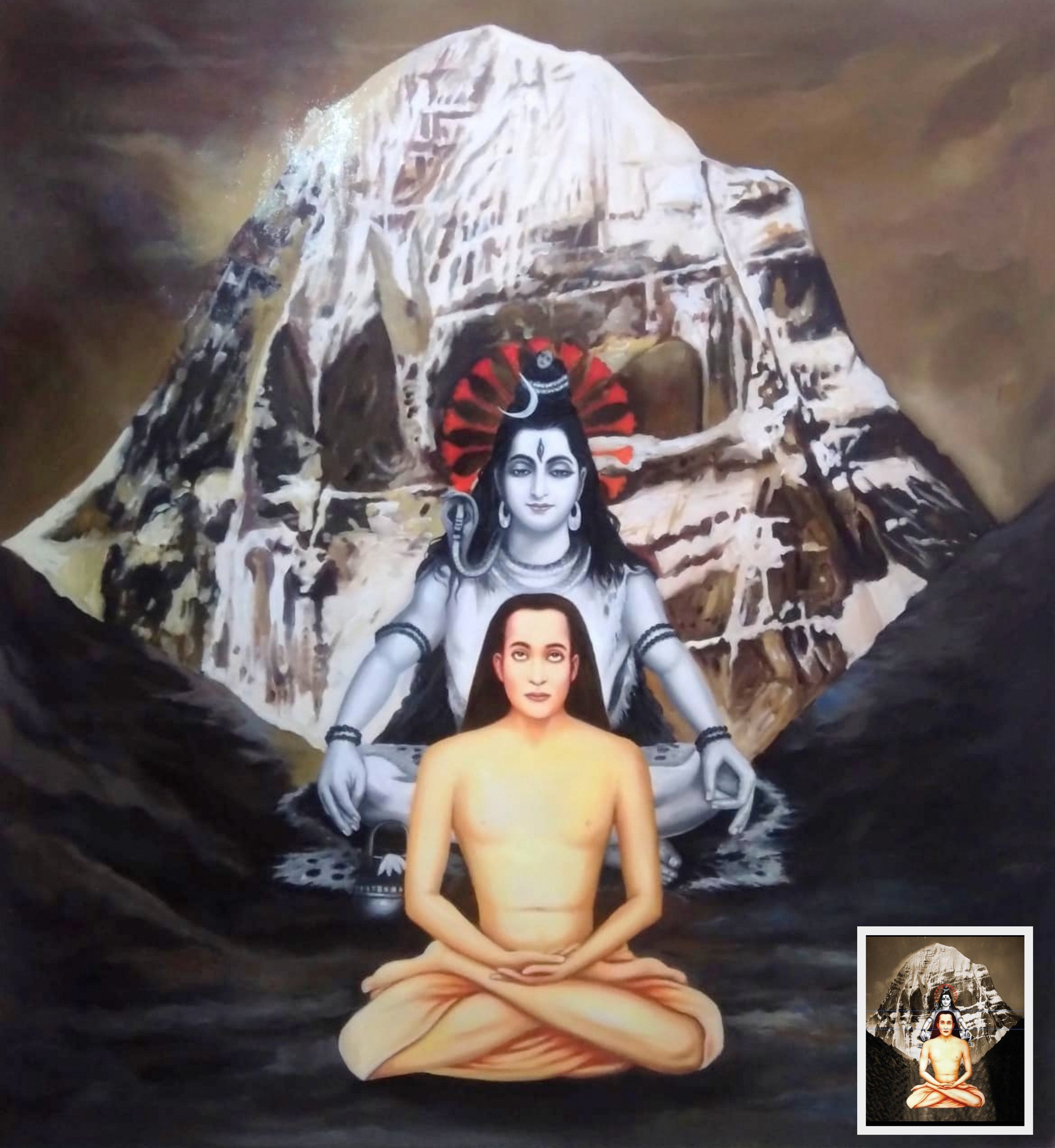 Oil painting of Lord Shiva and Mahavatar Babaji (Image Source: Paintphotographs.com)
Oil painting of Lord Shiva and Mahavatar Babaji (Image Source: Paintphotographs.com)
Title: Oil Portrait of Babaji in Meditation of Lord Shiva, in Kailasha
Creator: Paintphotographs
Date Created: 2020
Physical Dimensions: 52 inches x 54 inches (132.08 cm x 137.16 cm)
Medium: Oil portrait painting on canvas
Style: Realism
Location: Private Collection, India
Handmade Art Reproductions & Landscape Paintings
Shirdi Sai baba
Shirdi Sai Baba, also known as Sai Baba of Shirdi, was an Indian fakir and spiritual leader revered by followers of Hindu and Muslim faiths alike during and after his lifetime. Indications suggest Sai Baba was born close to Shirdi, in a location now in the west Indian state of Maharashtra, even if his birthplace and year are uncertain. In the Maharashtrian village of Pathri Sai Baba was born to a boatman named Ganga Bhavadia and his wife Devagiriamma. In another version of the story, Sai Baba was born in Tamil Nadu, his mother's name was Vaishnavdevi and his father's name was Abdul Sattar.
References to Lahiri Mahasaya can be found in Sampoorna Sripada Vallabha Charitam as the Guru to Sri Shirdi Saibaba, who initiated him to kriya yoga. It is notable, that Babaji was the Guru of Lahiri Mahasaya who became the Guru of Sai baba.
Sai Baba's moral teachings emphasize love, forgiveness, service to others, altruism, contentment, inner tranquility, and loyalty to God and the Guru. Sai Baba stressed the importance of "self-realization" and opposed "passion for transient things." He emphasized the significance of submission to the genuine Satguru, who can guide the student through the journey to divine consciousness.
He passed away on October 15, 1918, which also happened to be Vijayadashami. His remains were laid to rest at Shirdi's Buti Wada, which was later developed into a temple and is now called Shree Samadhi Mandir or Shirdi Sai Baba Temple.
Sai Baba and his teachings continue to be very relevant and popular among people. Many temples were built in his name not only in India but also in faraway countries like the United States, Trinidad and Tobago, Guyana, Suriname, Fiji, Mauritius, South Africa, Netherlands, Kenya, Benin, Cuba, Canada, Pakistan, Australia, United Kingdom, Germany, Japan, and New Zealand, who spread Sai Baba's message of universal love and brotherhood across the world.
The popularity of Sai Baba can be further gauged from the number of films and television programs made on this life and teachings.
In our research, we encountered a couple of popular questions about Sai Baba
Why number 9 is special for Sai Baba?
Mrs. Laxmibai Patil Shinde, a woman from a wealthy family and a fervent follower of Sai Baba, was one of Sai Baba's most dedicated disciples. She prepared Sai baba's food and his breakfast. When Sai Baba was on his deathbed in 1918, he gave her 9 silver coins for her ardent devotion and duty.
Sai Baba gave Laxmibai nine(9) silver coins after the Navaratri pooja, which represent the ninefold path of Bhakti (devotion), namely: (1) Shravana (listening), (2) Kirtana (3) Smarana (remembering), (4)Pada Sevena (resting at the feet), (5) Archana (worship), (6) Namaskaras (making obeisance), (7) Dasyas (service), (8) Sakhyatva (friendliness); (9)Atmanivedana is the (Surrender of the self).
Along with representing the nine-fold path of devotion, the offering of the nine coins marks the completion of Ambika's (Goddess Durga) pooja ritual after the Navaratri festival. Considering it was given following the Navaratri Pooja, it also stands for Navashakti. Another widely held belief is that this arrangement of the nine coins may also represent the Nava Graha, or the nine planets, which directly affect a man's life.
Why is Thursday special for Sai Baba?
Every Thursday, Sai Baba is carried in a palanquin from the Samadhi Mandir to Dwarkamayi, then to Chavdi, before returning to the Sai Baba Mandir. Regardless of caste, creed, or religion, devotees of all faiths are welcome to receive Darshan in the Samadhi Mandir and partake in prasad (blessed food) in the Prasadalaya.
Making Sai Baba’s portrait painting from a photo
We received commissions from our clients, devotees of Sai Baba to make portrait paintings of Sai Baba from photos shared by them. The above readings provided us with insights that helped us make the portrait painting of Sai Baba from the photo.
The first painting we did of Sai Baba was an oil portrait painting measuring 24 inches x 20 inches. As artists, we used religious iconography in the oil painting to convey the holy and saintly nature of Sai Baba. The portrait painting depicts Sai Baba in his usual attire, of a white robe and white head scarf (bandana) on his head, in a dark background. An inner light shines on his face as he gazes toward the heavens as if searching for God from a distance. The head, caught in a strong beam of light, stands out against the shadowed background. The expression on his face reveals his love and compassion for mankind. The impressionistic style was used to make the oil portrait painting.
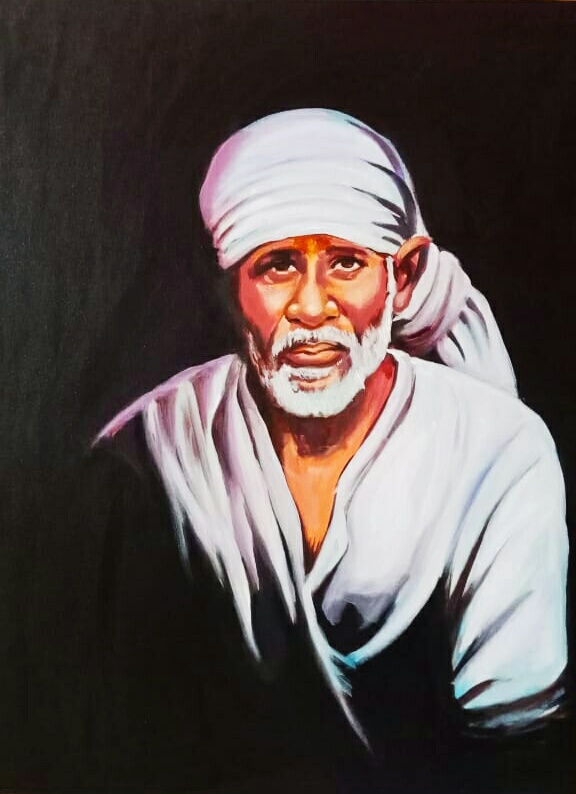 Oil Portrait Painting of Sai Baba of Shirdi (Image Source: Paintphotographs.com)
Oil Portrait Painting of Sai Baba of Shirdi (Image Source: Paintphotographs.com)
Title: Oil Portrait Painting of Sai Baba of Shirdi
Creator: Paintphotographs
Date Created: 2020
Physical Dimensions: 24 inches x 20 inches (60.96 cm x 50.8 cm)
Medium: Oil portrait painting on canvas
Style: Impressionistic
Location: Private Collection, India
Order Your Custom Handmade Oil Portrait Painting from Photo today
The second commission we received was from an old couple, ardent devotees of Sai Baba, who wanted us to create an oil painting that reflected Sai Baba's presence in their lives. Based on our understanding, research, and insights into the bond between Saibaba and his devotees, we created the painting, Sai Baba's Blessings.
The couple portrait painting measuring 24 inches x 20 inches, depicts the old couple walking with Saibaba blessing the couple from the heavens. The couple's oil portrait painting was made from a photo, shared by the client. We created Saibaba's portrait in the background as though he looking upon the couple from heaven, guiding their lives, and protecting them.
The pallet we chose for the oil painting were shades of yellow, white, and saffron, also the dominant colors of the painting. They represent the positive energy and love radiating from Saibaba, surrounding and embracing the couple in his warm energy, positive thoughts, and love as only a true Guru can feel for his followers.
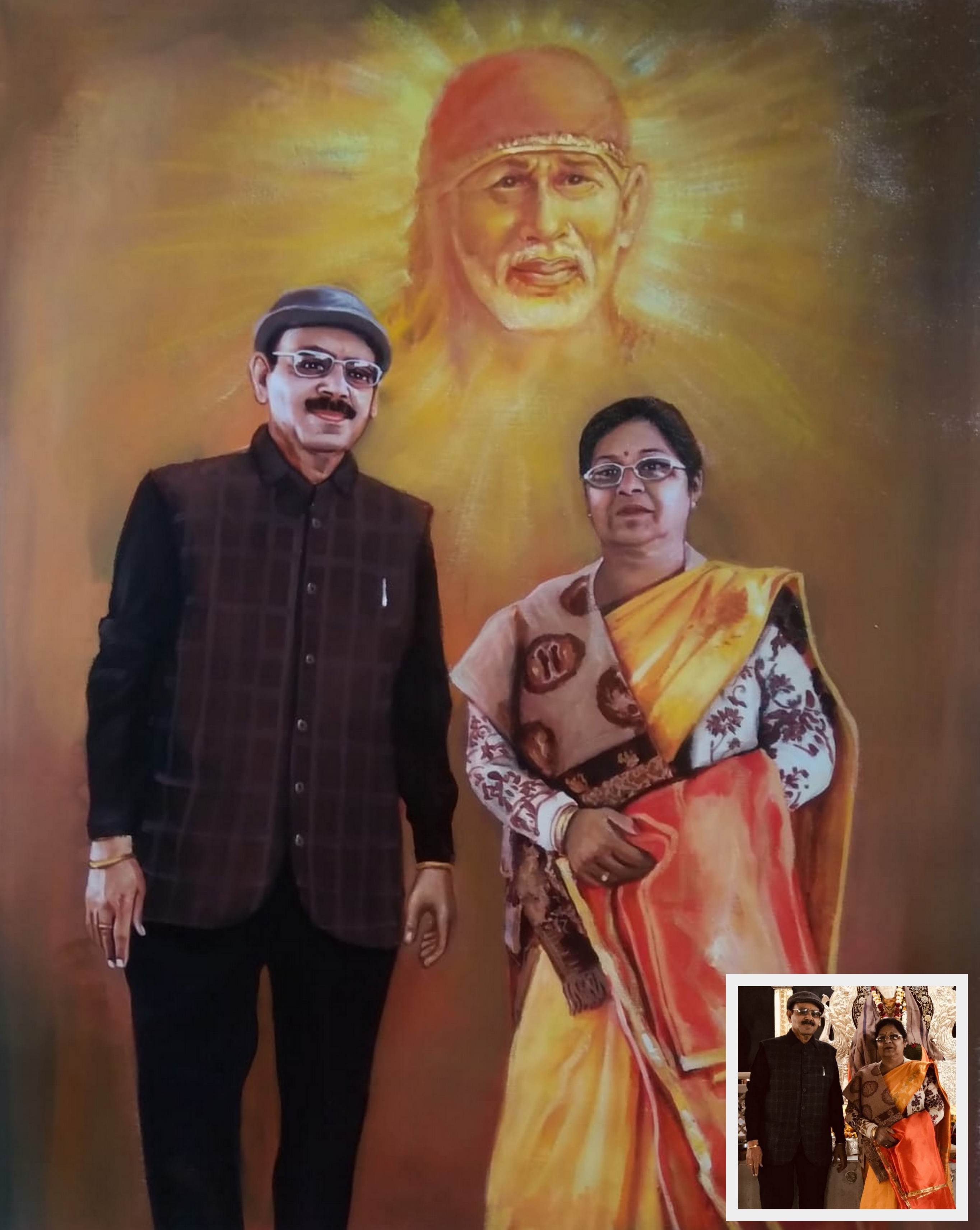 Sai Baba's Blessings Oil portrait painting (Image source: Paintphotographs.com)
Sai Baba's Blessings Oil portrait painting (Image source: Paintphotographs.com)
Title: Sai Baba's Blessings
Creator: Paintphotographs
Date Created: 2020
Physical Dimensions: 24 inches x 20 inches (60.96 cm x 50.8 cm)
Medium: Oil portrait painting on canvas
Style: Realism
Location: Private Collection, India
Pramukh Swami Maharaj
Pramukh Swami Maharaj was the fifth spiritual successor in Bhagwan Swaminarayan's succession of Gunatit gurus was born Shantilal Patel. Pramukh Swami was the guru and President of the Bochasanwasi Akshar Purushottam Swaminarayan Sanstha (BAPS), an important branch of the Swaminarayan Sampradaya, a Hindu sect.
On December 7th, 1921, in the Gujarati village of Chansad, Shantilal (Pramukh Swami) was born. His parents, Motibhai and Diwaliben Patel were adherents of the Akshar Purushottam faith and disciples of Shastriji Maharaj. From a young age, Shantilal (Pramukh Swami)had a strong inclination for spirituality. His daily visit to the Swaminarayan temple in Chansad and his friendship with Shastriji Maharaj and his pupil swamis demonstrated Shantilal's (Pramukh Swami) devotion to spirituality. Shantilal (Pramukh Swami) was seventeen years old on November 7, 1939, when he got a letter from his guru, Shastriji Maharaj, requesting that he join the swamis. Shantilal left his house that day to join Shastriji Maharaj and his swamis after receiving permission from his parents and their blessings.
At Ambli-Vadi Pol in Ahmedabad on November 22, 1939, Shastriji Maharaj gave Shantilal (Pramukh Swami) primary initiation, Parshad Diksha, and gave him his new name Shanti Bhagat. Shanti Bhagat (Pramukh Swami) received the Bhagvati Diksha, as a swami, and the name Narayanswarupdas Swami was given on January 10, 1940, at the Akshar Deri in Gondal. When naming him Narayanswarupdas, Shastriji Maharaj explained, "His face carries the brilliance of God, so I name him Narayanswarupdas"
Shastri Narayanswarupdas was only 28 years old when Shastriji Maharaj designated him the administrative president ("Pramukh") of BAPS on May 21, 1950, at Ambli-Vali Pol in Ahmedabad. In the decades following that, Shastri Narayanswarupdas became widely known as "Pramukh Swami".
BAPS quickly expanded under Pramukh Swami's leadership to become a worldwide Hindu organization. By 2019, BAPS under the leadership of Pramukh Swami had more than one million followers, over 900 swamis, 3,300 mandirs, and dozens of humanitarian projects. Pramukh Swami dedicated 1,000 temples in India and 125 temples overseas. Other cities where you can find these temples include Houston, Atlanta, Chicago, London, Toronto, and Nairobi. The Atlanta metro area temple is the largest outside of India.
Pramukh Swami oversaw BAPS' attempts to organize several significant cultural festivals to create greater awareness of and respect for Hindu traditions as well as encourage moral and spiritual behavior. Pramukh Swami accepted 1,000 young people into the swami fold during his lifetime, beginning with his inaugural ceremony in January 1971. For his discipline and faith,
Pramukh Swami came to be regarded as the "perfect saint" and "bhakta (devotee)", offering a concrete and understandable model for the aspirant to follow. His adherents believed that by following Pramukh Swami, they could get rid of their vices, primal impulses, and worldly attachments. Pramukh Swami served as the primary medium for a BAPS devotee's spiritual connection to God. Devotees of Swaminarayan believe Pramukh Swami Maharaj to be the manifestation of God (Swaminarayan).
In our research, we encountered a couple of popular questions about Pramukh Swami
When was Pramukh Swami born Maharaj born?
Pramukh Swami Maharaj, born Shantilal Patel on December 7th, 1921, in the Gujarati village of Chansad
Who gave Diksha to Pramukh Swami?
on November 22, 1939, Shastriji Maharaj gave Shantilal (Pramukh Swami) primary initiation, Parshad Diksha, and gave him his new name Shanti Bhagat. Shanti Bhagat received the Bhagvati Diksha, as a Swami, and the name Narayanswarupdas Swami was given on January 10, 1940, at the Akshar Deri in Gondal.
Who replaced Pramukh Swami?
After passing away on 13 August 2016, His Holiness Mahant Swami Maharaj succeeded Pramukh Swami Maharaj.
Making the oil portrait painting of Pramulk Swami from his image
Some years back we received a commission to make an oil portrait of Pramukh Swami Maharaj by his loyal devotees. Researching and reading about Pramukh Swami gave us understanding and insight into life's journey. The understanding helped us to make his portrait painting.
Initially, our client shared several photos to make the oil portrait of Pramukh Swami. We finally settled on a black and white photo of his which we felt was best suited for making his portrait painting. While portrait paintings are usually made in color, for Pramukh Swami Maharaj's oil portrait we decided to make a black-and-white oil portrait painting. The white color scheme lent a unique and spiritual outlook to the portrait painting.
Shastriji Maharaj said when he gave Diksha to Pramukh Swami Maharaj "His face carries the brilliance of God, so I name him Narayanswarupdas" this gave us a key insight into making his portrait painting from the photo.
The oil portrait depicts the kind and compassionate face of Pramukh Swami Maharaj, gazing far into the distance in the painting. The portrait painting captures his lustrous eyes shining with divine brightness, as he, contemplates life and its mysteries. A sense of peace and serenity in his expression. The look of hope and faith is painted in a way as to evoke hope and inspiration in the hearts of the devoted viewer. The only color used in the portrait painting is the red tilak on the forehead of Swamiji, which further attracts the attention of the viewer to his face. The background of the painting is shades of light grey and white, which add depth to the oil portrait.
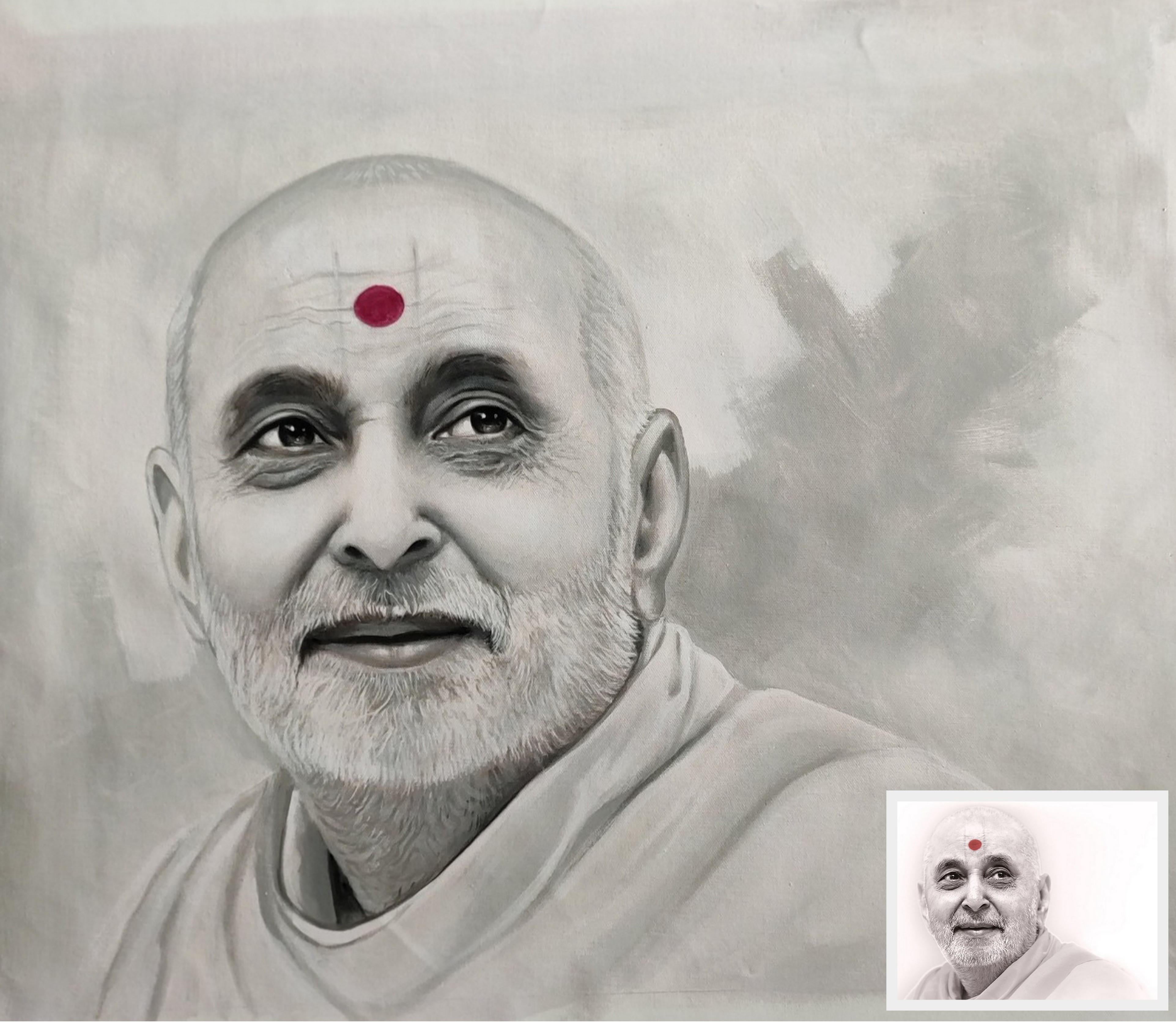
Oil Portrait Painting of Pramukh Swami Maharaj (Image Source: Paintphotographs.com)
Title: Portrait painting of Pramukh Swami Maharaj
Creator: Paintphotographs
Date Created: 2021
Physical Dimensions: 20 inches x 16 inches (50.8 cm x 40.64 cm)
Medium: Oil portrait painting on canvas
Style: Realism
Location: Private Collection, UK
Order Your Portrait Painting from Photo today!
Guru Jambheshwar
Guru Jambheshwar founded the Bishnoi Panth, sometimes referred to as Guru Jambhaji, and lived from 1451 to 1536. Guru Jambheshwar was born to a Rajput family of Lohatji and Hansadevi in Pipasar, a small village 50km from the town of Nagaur near Bikaner city. He propagated the idea that God is a universal divine force and to live in balance with Nature, he stressed the importance of protecting flora and animals.
In Samrathal Dhora, Guru Jambheshwar, then 34 years old, established the Bishnoi panth. He gave his instructions in the Shabadwani lyrical style. The sect was established after Rajasthan had a severe drought in 1485. Guru Jambheshwar had set 29 rules for the sect to observe. Tree cutting and animal slaughter are prohibited. The Bishnois community reveres the Khejri tree as a sacred tree.
Making the oil portrait painting of Guru Jambeshwar from his photo
A loyal devotee of Guru Jambheshwar commissioned us to make an oil portrait painting of him some years ago. The image he shared and our research into Jambheshwar, helped us to make the painting.
The oil portrait depicts Guru Jambheshwar as he is praying. With his hands clasped in prayer, with Japa mala (prayer beads) in his hands, and his beard flowing down his face as his lustrous eyes shone with divinity and compassion. Guru Jambheshwar's face is depicted as calm and serene as if he is in a deep state of meditation. He is depicted wearing simple saffron robes and a cape. A halo around his head symbolizes his divinity. The background is in shades of green, symbolizing his love for nature and its protection.
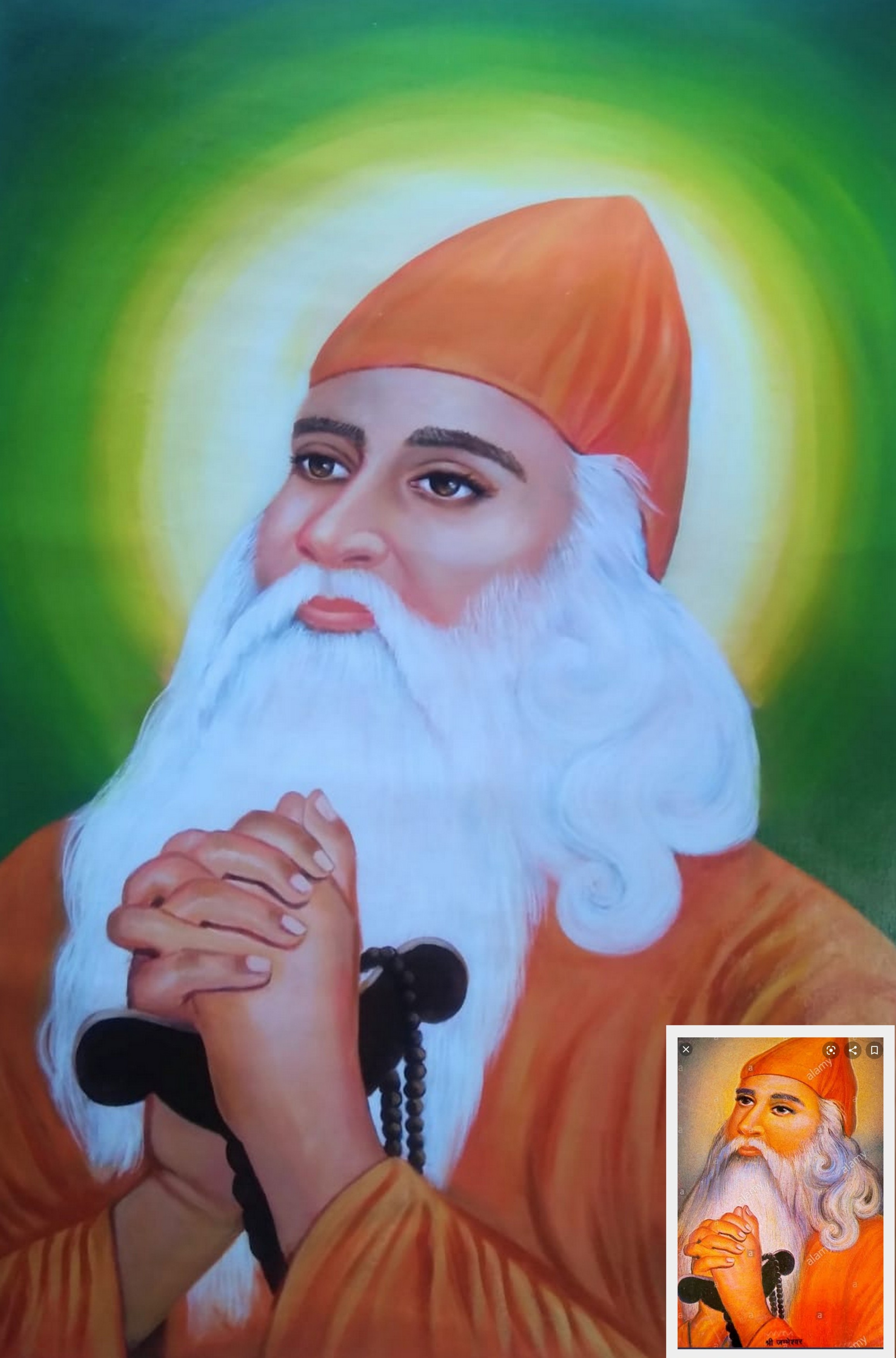 Guru Jambheshwar Oil Portrait Painting (Image Source: Paintphotographs.com)
Guru Jambheshwar Oil Portrait Painting (Image Source: Paintphotographs.com)
Title: Oil Portrait painting of Guru Jambheshwar
Creator: Paintphotographs
Date Created: 2021
Physical Dimensions: 36 inches x 24 inches (91.44 cm x 60.96 cm)
Medium: Oil portrait painting on canvas
Style: Realism
Location: Private Collection, India
Nigamanda Paramhansa
Swami Nigamananda Paramahansa (born Nalinikanta Chattopadhyay; 18 August 1880 – 29 November 1935 was an Indian yogi, guru, and mystic well-known in Eastern India. Nigamanda Paramhansa is associated with the Shakta tradition and is viewed as a perfect spiritual master of Vedanta, Tantra, yoga, and Prema or bhakti.
Nigamanda Paramhansa was born into a Bengali Brahmin family in the hamlet of Kutabpur in Nadia district (at present Meherpur district Bangladesh). He (Nigamanda Paramhansa) was a sannyasi from Adi Shankar's dashanami sampradaya. After his ordination as a sannyasi, he came to be known as Paribrajakacharya Paramahansa Srimat Swami Nigamananda Saraswati Deva.
Nigamanda Paramhansa set up several spiritual and Dharmic institutions, Nigamanda Paramhansa also founded Saraswata Matha with a mission to spread Sanatana Dharma (eternal religion), true education, and to serve everyone as God.
A loyal devotee of Nigamanda Paramhansa commissioned us to make an oil portrait painting of him from the photo he shared with us. Based on the image and our understanding we made the oil portrait of Nigamanda Paramhansa.
Making Nigamanda Paramhansa's oil portrait painting from his photo
The oil portrait of Nigamanda Paramhansa measuring 35 inches x 22 inches was created from a photo of him shared by his devotee. The oil portrait depicts the Guru Nigamanda Paramhansa sitting crossed-legged on a tiger skin, looking directly at the viewer as if he is communicating with his viewers. In the oil portrait, Guru Nigamanda Paramhansa is shown wearing rudraksha mala, his hands clasped together as if he is patiently listening to his devotees. The expression on his face bears the calm and composed look of a Guru who has achieved self-realization (Siddhi). Around his head is a halo of light signifying one who had achieved spiritual enlightenment. The painting style adopted for the oil portrait of Guru Nigamanda Paramhansa is realism, to give the viewer an authentic feel when viewing the portrait painting.
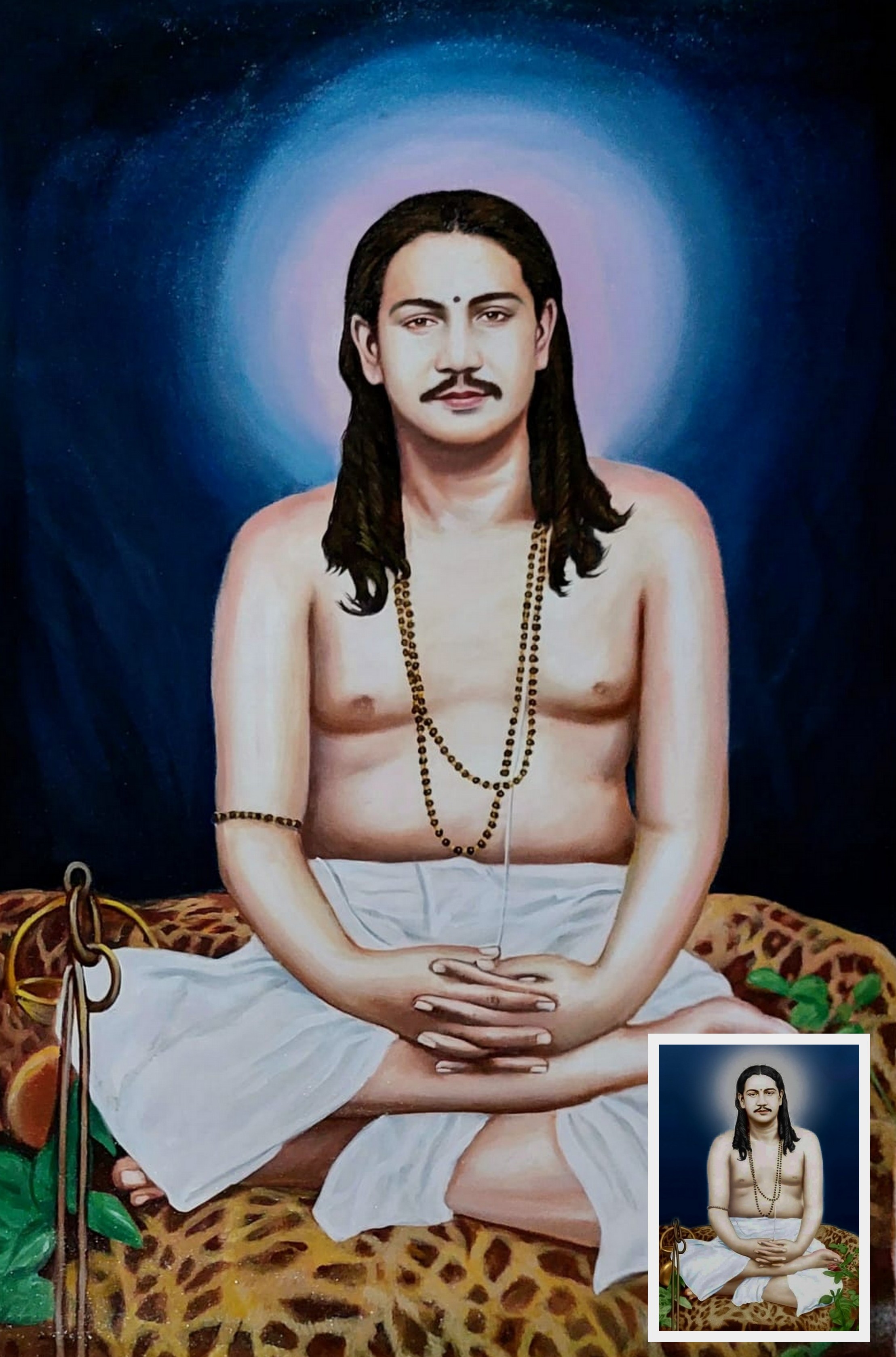 Nigamananda Paramahansa Oil Portrait Painting (Image Source: Paintphotographs.com)
Nigamananda Paramahansa Oil Portrait Painting (Image Source: Paintphotographs.com)
Title: Oil Portrait Painting of Nigamanda Paramhansa
Creator: Paintphotographs
Date Created: 2022
Physical Dimensions: 36 inches x 24 inches (91.44 cm x 60.96 cm)
Medium: Oil portrait painting on canvas
Style: Realism
Location: Private Collection, India
Rang Avadhoot Maharaj
Shri Rang Avadhoot was born Pandurang Vitthalapant Valame, on November 21, 1898. He belonged to the Hindu spiritual Datta-panth (Gurucharita tradition of Dattatreya). Before embracing asceticism, he worked as a social worker and a fighter for the Independence of the country. From early on, he had a religious bent. His education began at Godhra, where he graduated from Telang High School in 1917. Shri Rang Avadhoot enrolled in Gujarat College in Ahmedabad for higher education and finished his first year there. For his second year, he relocated to Baroda College. He postponed his studies in 1920 to join Mahatma Gandhi's non-cooperation movement.
Shri Rang Avadhoot gave up his career and adopted asceticism due to his spiritual inclination. He moved to Nareshwar on the banks of the Narmada river in December 1925 after spending some time at Ranapur. He chanted the Shri Dattapurana of Saraswati 108 times there. In 1927, Rang Avadhoot completed the 108-day on-foot Narmada Prarikrama, a devotional journey around the Narmada River. He practiced tapa and meditation (austerities). He finished the Parikrama once more in 1930. Shri Rang Avadhoot is revered by his devotees as a Dattatreya manifestation. He was crucial in establishing the Datta-panth (Path of Dattatreya) in Gujarat, India. His hermitage is at Nareshwar, Gujarat.
Shri Rang Avadhoot was fluent in four languages, Gujarati, Hindi, Marathi, English, and Sanskrit. He wrote and translated several works, including Leo Tolstoy's What Shall We Do Then? In Gujarati with Narhari Parikh. About 45 works were written after he accepted asceticism, mostly devoted to spirituality and devotion to Dattatreya.
Making the portrait painting of Rang Avadhoot Maharaj from his photo
A loyal devotee of Rang Avadhoot Maharaj commissioned us to make an oil portrait painting of him from the photo he shared with us. Based on the image and our understanding we made the oil portrait painting of Rang Avadhoot Maharaj.
The oil portrait of Rang Avadhoot Maharaj measuring 20 inches x 16 inches was created from a photo of him shared by his devotee. The oil portrait depicts him in a forest as he sits under a tree in a yogic posture of padmasana (cross-legged lotus position), in deep meditation of Dattareya (Yoga Lord), who hovers above his head. In the background, the river flows. His attire is a red loin cloth and a red cloth over his head. The oil portrait painting of Shri Rang Avadhoot was completed in a realistic style, with great attention to detail paid to Maharaj's face and posture. The colors used in the oil portrait painting are muted and natural, lending a calming feeling to the overall image. The painting captures the essence of Shri Rang Avadhoot Maharaj's spiritual practice and his deep connection to nature.
The client was extremely pleased with the oil portrait painting, as it was exactly how he imagined it. It now hangs in his home bringing peace and joy to his family.
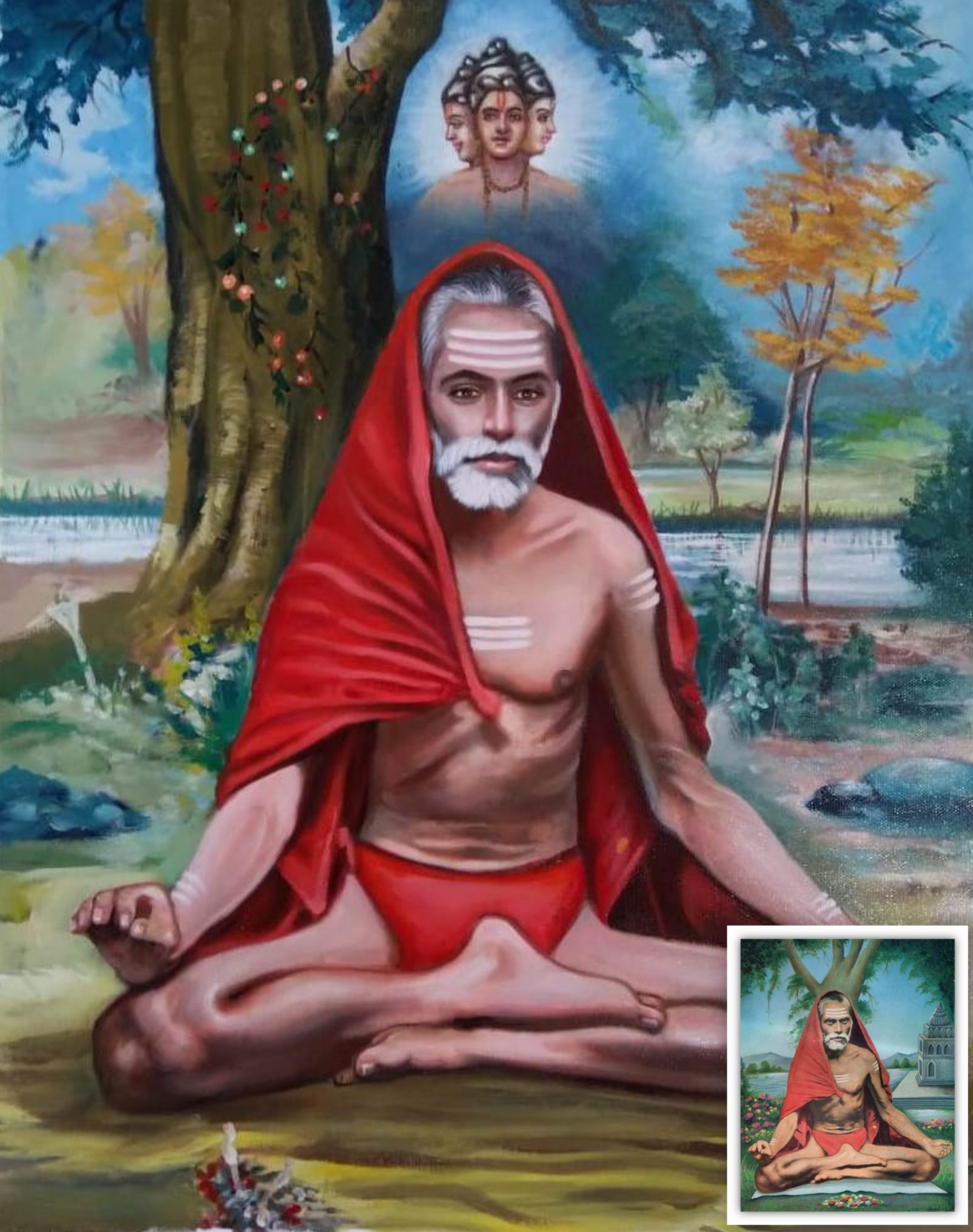 Painting of Rang Avadhoot Maharaj in Deep Meditation (Image Source: Paintphotographs.com)
Painting of Rang Avadhoot Maharaj in Deep Meditation (Image Source: Paintphotographs.com)
Title: Painting of Rang Avadhoot Maharaj in Deep Meditation
Creator: Paintphotographs
Date Created: 2019
Physical Dimensions: 20 inches x 16 inches (50.08 cm x 40.64 cm)
Medium: Oil painting on canvas
Style: Realism
Location: Private Collection, India
Conclusion:
The spiritual land of India has long been a source of wisdom and enlightenment for seekers of truth from all over the world. The great Sages and Gurus who have arisen from this land have helped countless people to realize their potential and find inner peace. The oil portrait painting we made is an effort to honor these great individuals and their contributions to our lives. We consider ourselves fortunate to have had the chance to make their portrait paintings
About Us:
Paintphotographs.com is India's leading custom art platform. We turn your favorite photos, pics, and images into luxurious handmade portrait paintings. Our work includes handmade portraits, custom oil reproductions, charcoal drawings, and sketches. As a team of accomplished artists, we use museum-quality canvas, the best international brands of colors such as Winsor & Newton and Daler Rawney. We work with various mediums, including oil, acrylic, mixed media, graphite, and charcoal.
To order a custom handmade oil portrait painting you can visit our order now page. You can order custom Wedding Paintings, Couple Paintings, Memorial Paintings, Family Paintings, Baby portraits and Children Paintings, Photo to paintings, and Pet Portrait Paintings from Photo.
You can visit our pricing page to know the prices of our portrait paintings. To connect with us ping us on our chat messenger on the website, ping us on WhatsApp, call us at 918291070650, or drop us an email at support@paintphotographs.com
You can visit our gallery pages to see our work. We make photo to paintings, couple paintings, memorial paintings, Kids and Baby Portrait paintings, God & Religious Paintings, Old Photo to Paintings, Wedding couple Paintings & Marriage Portraits, Family Paintings, Pet Portrait Paintings, Radha Krishna Paintings, Oil Portraits of Gurus, Saints & Holy Men, Charcoal and Pencil Sketches, Custom Landscape & Cityscape paintings, Contemporary Art Reproduction & Replica Paintings, Old Master Reproduction & Replica Art, Monochrome and Black & White portrait paintings, Historical Portraits and Shivaji Maharaj Paintings, Celebrity & Political Leaders Portraits. We can also merge separate photos to create a single seamless painting called Composite portraits to add deceased loved ones to make a family oil portrait as though they were present.
Our custom handmade portraits make beautiful Anniversary Gifts, Engagement Gifts, Birthday Gifts, Retirement Gifts, Housewarming Gifts, Mother's Day gifts, and luxurious gifts for many important occasions.
Paintphotographs.com provides bespoke services for art patrons, interior designers, and architects. It helps you create the perfect pieces for residential and commercial projects and serves as a platform for artists to showcase their work.
If you are an art aficionado interested in writing a guest post on art, connect with us.
Want to read more? Check our reading recommendations below! Please refer to the Notes and Reference section for sources referenced in the article.
Like this story? Then you will love our podcasts on Spotify. Listen to our deep dives and fascinating stories from the art world. Join our nearly 20,000-strong community on Facebook, WhatsApp, and X.
Want to see our art? Join our community of 500,000+ subscribers on the Paintphotographs YouTube channel, Instagram, and Pinterest for some amazing art pics & art videos!
Notes and reference section
https://www.google.co.in/books/edition/Autobiography_of_a_Yogi/Wymi_jlaFI4C?hl=en
How the 'Sgt. Pepper' cover might have looked today | CNN
https://www.google.co.in/books/edition/Sai_Baba_of_Shirdi_English/xQccAAAAIAAJ?hl=en
https://www.google.co.in/books/edition/Yug_Purush_Pujya_Pramukh_Swami_Maharaj/g7oqPwAACAAJ?hl=en
https://www.google.co.in/books/edition/Sadguru_Nigamananda/nrkcAAAAMAAJ?hl=en
Shodhganga@INFLIBNET: Rang Avadhootna sahitya ma vyakt thatu shaikshanik chintan

